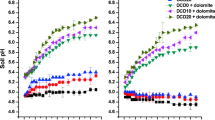Abstract
Nitrification inhibition of soil and applied fertilizer N is desirable as the accumulation of nitrates in soils in excess of plant needs leads to enhanced N losses and reduced fertilizer N-use efficiency. In a growth chamber experiment, we studied the effects of two commercial nitrification inhibitors (NIs), 4-amino 1,2,4-triazole (ATC) and dicyandiamide (DCD), and a commonly available and economical material, encapsulated calcium carbide (CaC2) (ECC) on the nitrification of soil and applied NH4 +-N in a semiarid subtropical Tolewal sandy loam soil under upland [60% water-filled pore space (WFPS)] and flooded conditions (120% WFPS). Nitrification of the applied 100 mg NH4 +-N kg–1 soil under upland conditions was retarded most effectively (93%) by ECC for up to 10 days of incubation, whereas for longer periods, ATC was more effective. After 20 days, only 16% of applied NH4 +-N was nitrified with ATC as compared to 37% with DCD and 98% with ECC. Under flooded soil conditions, nitrates resulting from nitrification quickly disappeared due to denitrification, resulting in a tremendous loss of fertilizer N (up to 70% of N applied without a NI). Based on four indicators of inhibitor effectiveness, namely, concentration of NH4 +-N and NO3 –-N, percent nitrification inhibition, ratio of NH4 +-N/NO3 –-N, and total mineral N, ECC showed the highest relative efficiency throughout the 20-day incubation under flooded soil conditions. At the end of the 20-day incubation, 96%, 58% and 38% of applied NH4 +-N was still present in the soil where ECC, ATC and DCD were used, respectively. Consequently, nitrification inhibition of applied fertilizer N in both arable crops and flooded rice systems could tremendously minimize N losses and help enhance fertilizer N-use efficiency. These results suggest that for reducing the nitrification rate and resultant N losses in flooded soil systems (e.g. rice lowlands), ECC is more effective than costly commercial NIs.
Similar content being viewed by others
Author information
Authors and Affiliations
Additional information
Received: 25 May 2000
Rights and permissions
About this article
Cite this article
Aulakh, M., Kuldip-Singh, . & Doran, J. Effects of 4-amino 1,2,4-triazole, dicyandiamide and encapsulated calcium carbide on nitrification inhibition in a subtropical soil under upland and flooded conditions. Biol Fertil Soils 33, 258–263 (2001). https://doi.org/10.1007/s003740000317
Issue Date:
DOI: https://doi.org/10.1007/s003740000317




